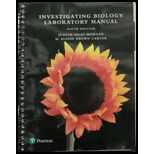
Concept explainers
(a)
To identify: The genes expressed in a specific type of brain cell.
Introduction:
A particular gene can be identified through its expression in a particular cell and its interaction with other genes. To study the gene expression, specific mRNAs corresponding to a gene of interest are to be identified and reverse transcribed to form cDNA. This sequence can be identified through RT-PCR, DNA microarray analysis, and RNA sequencing. To study a particular protein, multiple copies of the gene fragment encoding that protein are synthesized through polymerase chain reaction (PCR). These gene fragments are then inserted into the expression vector to synthesize a large quantity of proteins encoded by the gene in a process known as gene cloning.
(b)
To isolate: The neurotransmitter gene expressed in brain cells.
Introduction:
A particular gene can be identified through its expression in a particular cell and its interaction with other genes. To study the gene expression, specific mRNAs corresponding to a gene of interest are to be identified and reverse transcribed to form cDNA. This sequence can be identified through RT-PCR, DNA microarray analysis, and RNA sequencing. To study a particular protein, multiple copies of the gene fragment encoding that protein are synthesized through polymerase chain reaction (PCR). These gene fragments are then inserted into the expression vector to synthesize a large quantity of proteins encoded by the gene in a process known as gene cloning.
(c)
To produce: Multiple copies of the gene encoding for neurotransmitter protein.
Introduction:
A particular gene can be identified through its expression in a particular cell and its interaction with other genes. To study the gene expression, specific mRNAs corresponding to a gene of interest are to be identified and reverse transcribed to form cDNA. This sequence can be identified through RT-PCR, DNA microarray analysis, and RNA sequencing. To study a particular protein, multiple copies of the gene fragment encoding that protein are synthesized through polymerase chain reaction (PCR). These gene fragments are then inserted into the expression vector to synthesize a large quantity of proteins encoded by the gene in a process known as gene cloning.
(d)
To produce: Large quantities of the neurotransmitter.
Introduction:
A particular gene can be identified through its expression in a particular cell and its interaction with other genes. To study the gene expression, specific mRNAs corresponding to a gene of interest are to be identified and reverse transcribed to form cDNA. This sequence can be identified through RT-PCR, DNA microarray analysis, and RNA sequencing. To study a particular protein, multiple copies of the gene fragment encoding that protein are synthesized through polymerase chain reaction (PCR). These gene fragments are then inserted into the expression vector to synthesize a large quantity of proteins encoded by the gene in a process known as gene cloning.
Want to see the full answer?
Check out a sample textbook solution
Chapter 20 Solutions
Investigating Biology Laboratory Manual (9th Edition)
- Selection of Traits What adaptations do scavengers have for locating and feeding on prey? What adaptations do predators have for capturing and consuming prey?arrow_forwardCompetition Between Species What natural processes limit populations from growing too large? What are some resources organisms can compete over in their natural habitat?arrow_forwardSpecies Interactions Explain how predators, prey and scavengers interact. Explain whether predators and scavengers are necessary or beneficial for an ecosystem.arrow_forward
- magine that you are conducting research on fruit type and seed dispersal. You submitted a paper to a peer-reviewed journal that addresses the factors that impact fruit type and seed dispersal mechanisms in plants of Central America. The editor of the journal communicates that your paper may be published if you make ‘minor revisions’ to the document. Describe two characteristics that you would expect in seeds that are dispersed by the wind. Contrast this with what you would expect for seeds that are gathered, buried or eaten by animals, and explain why they are different. (Editor’s note: Providing this information in your discussion will help readers to consider the significance of the research).arrow_forwardWhat is the difference between Uniporters, Symporters and Antiporters? Which of these are examples of active transport?arrow_forwardWhat are coupled transporters?arrow_forward
- How do histamine and prostaglandins help in the mobilization of leukocytes to an injury site? What are chemotactic factors? How do they affect inflammation process?arrow_forwardCompare and contrast neutrophils and macrophages. Describe two ways they are different and two ways they are similar.arrow_forwardDescribe the effects of three cytokines (not involved in the initial inflammation response). What cells release them?arrow_forward
 Biology (MindTap Course List)BiologyISBN:9781337392938Author:Eldra Solomon, Charles Martin, Diana W. Martin, Linda R. BergPublisher:Cengage Learning
Biology (MindTap Course List)BiologyISBN:9781337392938Author:Eldra Solomon, Charles Martin, Diana W. Martin, Linda R. BergPublisher:Cengage Learning
